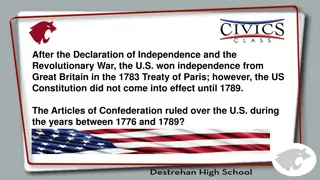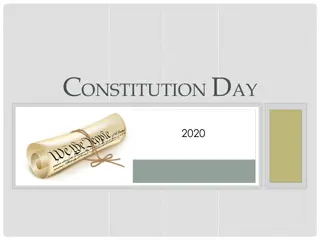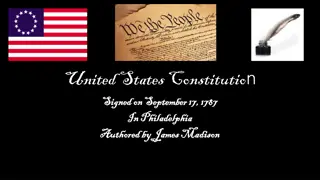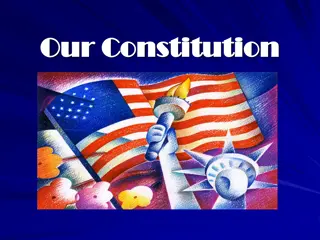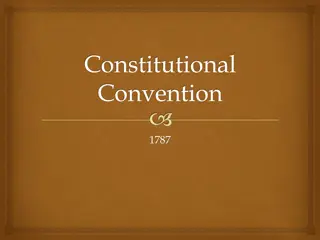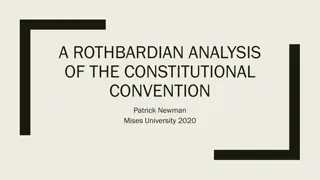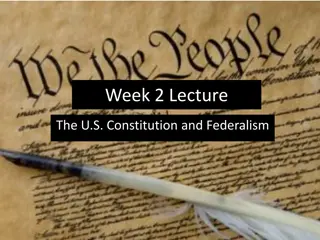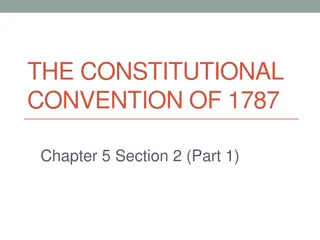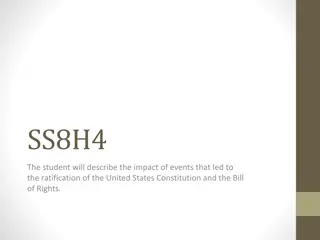French Revolution
Explore the transformative period of the French Revolution, starting with the Noble Revolt in 1787 and leading to the rise of a Radical Republic, the Terror of 1793-1794, and the eventual establishment of a Napoleonic Dictatorship. Learn about the key events, influential figures like Toussaint L'Ouv
4 views • 4 slides
Women as Doctoral Supervisors: Dismantling the Traditional System
Exploration of the emergence of women as doctoral supervisors in academia, tracing the historical context from the first known female doctoral candidate in 1787 to the gradual inclusion and impact of women in doctoral education. The evolution of the modern PhD and the changing dynamics of supervisio
0 views • 11 slides
Shaping a New Nation: Challenges of the Articles of Confederation
Americans initially adopted the Articles of Confederation as their first government, but soon realized its weaknesses. The lack of a strong central authority, debate over power distribution, limitations on the national government's powers, and challenges in governing newly acquired lands were key is
2 views • 42 slides
Evolution from Articles of Confederation to U.S. Constitution
Following the Revolutionary War, the U.S. initially operated under the Articles of Confederation, which provided for a weak central government. However, due to issues such as financial problems and Shays' Rebellion, the Constitutional Convention was called in 1787. This led to the creation of the U.
0 views • 8 slides
Constitution Day: History and Significance of September 17, 1787
Celebrate Constitution Day by learning about the signing of the United States Constitution on September 17, 1787. Discover the 39 delegates who signed the Constitution, the principles it upholds, and the seven articles that form the foundation of the American government.
2 views • 17 slides
Understanding the United States Constitution and Federalism
Delve into the history and significance of the United States Constitution, authored by James Madison in 1787. Explore the debate of ratification, Federalist vs. Anti-Federalist arguments, and the concept of Federalism, with a focus on the balance of powers between the central and state governments.
1 views • 23 slides
The Signing of the United States Constitution in 1787
A group of men gathered at the Constitutional Convention in 1787 in Philadelphia to draft a constitution for the newly formed United States. Led by George Washington, they discussed, argued, and made key decisions in secret meetings. James Madison meticulously recorded the discussions while Benjamin
1 views • 17 slides
The Constitutional Convention of 1787 and the Birth of the American Constitution
The Constitutional Convention of 1787 was convened to address the weaknesses of the Articles of Confederation and create a stronger central government. Delegates like George Washington, James Madison, and Alexander Hamilton played key roles in drafting the Constitution, which required ratification b
0 views • 5 slides
Evolution of Governance in the United States: Shays' Rebellion to the Constitutional Convention
Shays' Rebellion, led by Daniel Shays in 1786-1787, highlighted the weaknesses of the Articles of Confederation, prompting the Constitutional Convention in 1787. Despite challenges and delays, key figures like James Madison and George Washington played significant roles in shaping the new governance
0 views • 11 slides
Cronyism and Special Interests: A Rothbardian Analysis of the Constitutional Convention
Explore how the U.S. Constitution was influenced by cronyism and special interests through the lens of Murray Rothbard's analysis. The presentation delves into how Federalists at the 1787 Constitutional Convention secured privileges, passed special interest legislation, and shaped key clauses to ben
0 views • 23 slides
The Evolution of U.S. Government: From Declaration of Independence to Constitution
The journey from the Declaration of Independence in 1776 to the Constitutional Convention in 1787 marked a crucial phase in American history. Beginning with the assertion of unalienable rights to the creation of a more effective and legitimate government through the Great Compromise, this period sha
0 views • 17 slides
Key Events in American History Illustrated
Explore significant moments in American history through visual representations, including the founding of Jamestown in 1607, the signing of the Mayflower Compact in 1620, the writing of the Declaration of Independence in 1776, and the Louisiana Purchase in 1803. Learn about the Constitution of the U
0 views • 11 slides
The Constitutional Convention of 1787: Key Plans and Compromises
The Constitutional Convention of 1787 aimed to address issues with the Articles of Confederation by considering the Virginia and New Jersey Plans. The Great Compromise led to the formation of a bicameral Congress with proportional representation in the House of Representatives and equal representati
0 views • 17 slides
Weaknesses of the Articles of Confederation and Land Policies Explained
The weaknesses of the Articles of Confederation, including the lack of provision for adding new states, the Land Ordinance of 1785, and the Northwest Ordinance of 1787, are explored. The reasons behind these weaknesses are discussed, shedding light on the challenges faced by the early American gover
0 views • 8 slides
The Impact of Georgia's Role in the Constitutional Convention of 1787
Georgia played a significant role in the Constitutional Convention of 1787, influencing the Three-Fifths Compromise and the Great Compromise. The involvement of Georgian delegate Abraham Baldwin led to the bicameral legislative branch of the government. The writings of William Pierce offer valuable
0 views • 16 slides



